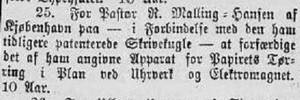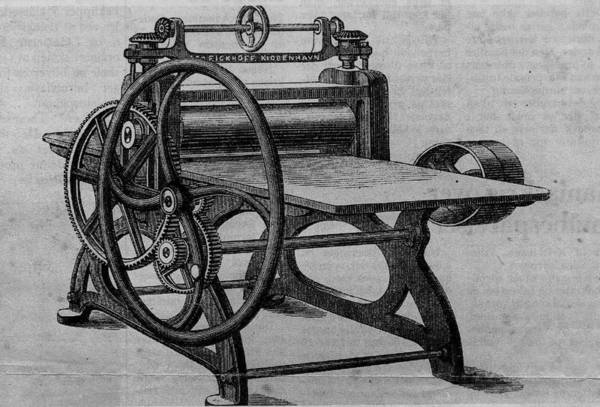Rasmus Malling-Hansen’s Norwegian Patent on an Instrument for Drying of Paper.
Research, transcription, translation and comments by Jørgen Malling Christensen.
Two Norwegian daily newspapers – ‘Morgenbladet (Christiania)’11 December 1873 and ‘Aftenposten’ on 8 December 1873 – list the Norwegian patents recently granted, and among them is an invention by Malling-Hansen, described as follows:
“25. For Pastor R.Malling-Hansen of Copenhagen – in connection with his previously patented writing ball – to produce the instrument indicated by him for drying of paper in levels, with clock and electromagnet. 10 years.”
The original text is as follows:
“25. For Pastor R.Malling-Hansen af Kjøbenhavn paa – i Forbindelse med den ham tidligere patenterede Skrivekugle – at forfærdige det af ham angivne Apparat for Papirets Tørring i Plan ved Uhrverk og Elektromagnet. 10 Aar.”
None of the two dailies inform about the date of the patent, but since both newspapers regularly – with an interval of 2-3 weeks – used to inform their readers about new Norwegian patents granted, we must assume that Malling-Hansen’s patent was granted in the last week of November or in the first week of December. I suggest that we – until further information is found – chose December 1, 1873 as a likely date of this patent.
What was Malling-Hansen’s motivation for inventing such a device? My guess is that the need arose with his invention of the xerography method, whereby he was able to print up to ten copies of a typed manuscript, using a glazing machine (in Danish ‘satinermaskine’) and blue ink. His xerography method (meaning ‘dry print’)was invented in 1872 (see our articles about xerography)and hence the next invention – in 1873 of the instrument for drying papers – is closely linked to the previous one.
To understand the need for drying papers, I will quote from an article in the Danish magazine ‘Illustreret Tidende’, published December 8, 1872, explaining some details of the xerography method:
“The new idea of this method rests on the lucky discovery which pastor Malling Hansen made some time ago, that the writing from the mentioned blue ink paper u n d e r c e r t a i n c o n d i t i o n s can be printed many times without losing its colour. The colour from black or brown or other kinds of ink only gives a few useable prints, whereas the blue paper, if it is of the very intensive colour called Berliner Blue, alone is capable of giving the surprisingly high number of prints. Of the suggested conditions the following are the most important: The ink paper must be thin and the colour on it must be finely grinded, preferably much finer than the colour one usually buys. Next, the oil paper must be thin, hard and very dry; that the paper is saturated with oil and that it is dry and hard has the effect that it can take up the colour from the ink paper without absorbing it, and is thus able to give it off again”.
From the above description it becomes clear that for Malling-Hansen’s dry copy method to work well, he needed, among other things, the oil paper “to be very dry”. Hence, he invented the device for drying of papers as a means to quickly and efficiently dry the oil papers – and possibly also the papers on onto which the imprint had been made. My assumption is here that as soon as the copied papers left the glazing machine, they were humid from the ink and needed to dry in such a way that they remained smooth (no wrinkles) and without smudges. If that is a correct assumption, then his new invention would hold each paper, as well as the essential oil papers, in a firm manner, allowing air flow for drying.
The electromagnet could be the source of power for a fan and for the clock. He had probably made experiments concerning the appropriate time for drying out 10 (e.g.) pieces of paper.
As far as I know, this is our first discovery that Malling-Hansen invented a method and a particular device for paper drying.
It was patented in Norway around December 1, 1873, and it is highly likely that further research will reveal his other patents for the method: probably the first one from Denmark, followed by some other European nations, such as was the case with his patents for the writing ball.
The other interesting aspect of the short notice in the Norwegian daily is that it clearly refers back to a previously Norwegian patent concerning his writing ball! We are yet to find hard documentary evidence, but it is clear that Malling-Hansen obtained a Norwegian patent for his writing ball sometime before December 1873.
What we do know – and evidence is published in our articles from Malling-Hansen’s lifetime – is that he obtained another Norwegian patent on January 21, 1879 of “10 years for improvements to the previously patented writing ball”.



